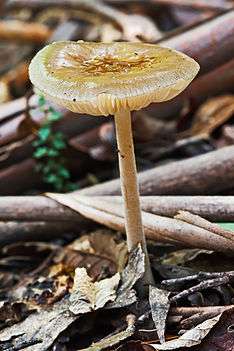Xerula australis
| Xerula australis | |
|---|---|
 | |
| Scientific classification | |
| Kingdom: | Fungi |
| Division: | Basidiomycota |
| Class: | Agaricomycetes |
| Order: | Agaricales |
| Family: | Physalacriaceae |
| Genus: | Xerula |
| Species: | X. australis |
| Binomial name | |
| Xerula australis (Dörfelt) R.H.Petersen (1994) | |
| Synonyms[1] | |
Xerula australis is a species of gilled mushroom in the family Physalacriaceae that is found in Australia. It was originally described in 1984 by German mycologist Heinrich Dörfelt.
Description
The cap is 5 to 8 cm (2.0 to 3.1 in) in diameter, and brownish in color. The cap surface is moist, somewhat sticky, with conspicuous striations (grooves) at the margin. The gills have an adnate attachment to the stipe, are whitish in color, changing to buff in maturity, sometimes with a tinge of pink in older specimens. The whitish stipe is 8 to 11 cm (3.1 to 4.3 in) by 0.7 to 1.0 cm (0.3 to 0.4 in) thick, covered with small particles (furfuraceous) or small hairs (tomentose); the stipe bruises to a gray-tan color.[4] Like other Xerula species, X. australis has a characteristic root-like rhizomorph that extends down in the soil, usually attached to rotting wood under the fruitbody. The spore print is white.
The spores are ellipsoid, smooth, and hyaline, with dimensions of 12–16 to 8–11 µm.[5]
Habitat and distribution
Xerula australis has been recorded growing singly or in groups on sandy soil in Southern Australia.[4] Smith (2005) notes that in the Bunya Mountains of south-east Queensland, the fungus may be found fruiting in large groups on dead roots in the rainforest, but it is also associated with eucalypt forests and woodland.[5]
References
- ↑ "Xerula australis (Dörfelt) R.H. Petersen". MycoBank. International Mycological Association. Retrieved 2015-04-30.
- ↑ Dörfelt H. (1984). "Taxonomische Studien in der Gattung Xerula R. Maire – IX". Feddes Repertorium Specierum Novarum Regni Vegetabilis (in German). 95: 189–200.
- ↑ Pegler DN, Young TWK (1987). "Classification of Oudemansiella (Basidiomycota: Tricholomataceae), with special reference to spore structure". Transactions of the British Mycological Society. 87 (4): 583–602. doi:10.1016/s0007-1536(86)80099-7.
- 1 2 Petersen RH, Methven AS (1994). "Mating systems in the Xerulaceae —Xerula". Canadian Journal of Botany. 72: 1161–63. doi:10.1139/b94-141.
- 1 2 Smith KN. (2005). A Field Guide to the Fungi of Australia. Sydney, NSW, Australia: University of New South Wales Press. p. 186. ISBN 978-0-86840-742-5.